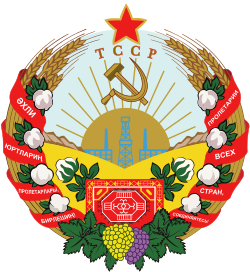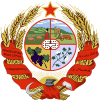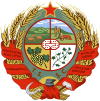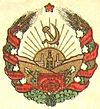Emblem of the Turkmen Soviet Socialist Republic facts for kids
Quick facts for kids Emblem of the Turkmen Soviet Socialist Republic |
|||||||||||||
|---|---|---|---|---|---|---|---|---|---|---|---|---|---|
 |
|||||||||||||
| Armiger | Turkmen Soviet Socialist Republic | ||||||||||||
| Adopted | 2 March 1937 | ||||||||||||
| Crest | Red star | ||||||||||||
| Supporters | Cotton, wheat and grapes | ||||||||||||
| Motto | Әxли юртлариң пролетарлары, бирлешиң! (Turkmen) Пролетарии всех стран, соединяйтесь! (Russian) "Workers of the world, unite!" |
||||||||||||
| Earlier version(s) |
|
||||||||||||
The Emblem of the Turkmen Soviet Socialist Republic was the official symbol of the Turkmen Soviet Socialist Republic (Turkmen SSR). This emblem was adopted on March 2, 1937. It was designed based on the Soviet Union's coat of arms.
The emblem shows important parts of the Turkmen SSR. It includes symbols for farming, like cotton, wheat, and grapes. It also features symbols for industry, such as an oil derrick and a pipeline. A special rug pattern represents the Turkmen people.
The Sun rising in the background stands for a bright future for the Turkmen nation. The red star and the hammer and sickle are symbols of the Soviet system and its goals.
Around the emblem, there is a banner with a famous motto: "Workers of the world, unite!" This phrase is written in both the Russian and Turkmen languages. In Turkmen, it says: "Әxли юртлариң пролетарлары, бирлешиң!"
Later versions of the emblem sometimes included the letters "TSSR" (for Turkmen Soviet Socialist Republic) between the red star and the hammer and sickle. The emblem was replaced in 1992 by the current Emblem of Turkmenistan, but some parts of the old design were kept.
Contents
History of the Emblem
The emblem of the Turkmen SSR changed a few times over the years. Each change reflected new ideas or updates in the republic.
Early Designs
When the Turkmen SSR was first formed, it didn't have its own official emblem. For a while, it used the emblem of the larger Soviet Union.
In 1926, a group was set up to create a unique emblem for the Turkmen SSR. The first design was approved in October 1926.
First Look (1926)
The first emblem design had several interesting features:
- A round shield on a blue-green background, with rays of a rising sun.
- The shield was divided into four parts. In the middle was a "salor gol," which is a traditional Turkmen rug pattern.
- Inside the shield, there were images like mulberry leaves, a butterfly, a cocoon, grapes, a camel, a tractor, and cotton branches.
- Wheat ears surrounded the shield, tied with a red ribbon.
- The motto "Workers of all countries, unite!" was on the ribbon in Russian, Armenian, Turkmen, and Persian.
- At the bottom, there was an anvil and a hammer. A red star was at the top, between the wheat ears.
Small Changes (1927)
In 1927, the emblem was slightly updated.
- The mulberry leaf and butterfly were replaced by a herd of sheep and goats with a Turkmen shepherd, set against the Kopet Dag mountains.
- A driver and a plow were added to the tractor.
- The bunches of grapes became a single ripe bunch.
- The cotton branches became one branch with two open cotton bolls.
- The motto was now only in Russian and Turkmen.
Language Update (1927-1928)
Later in 1927, the writing on the emblem changed from Arabic letters to Latin letters. The motto in Turkmen became: "BYTIN JER JYZINIꞐ PROLETARLARЬ, BIRLEŞIꞐ!". This change happened even before Latin letters were officially adopted for all government uses in 1928-1929. The letters "T.S.Ş.Ç" were also added, which stood for "Turkmenistan Socialist Soviet Republic" in the new Latin script.
The Main Emblem (1937)
The most well-known version of the emblem was adopted on March 2, 1937. This design was created by artist Alexander Pavlovich Vladychuk.
People discussed the design, and some felt it needed to show more than just farming. They wanted it to also represent the growing industry in Turkmenistan. So, elements like factory buildings were added.
The 1937 emblem included:
- A golden hammer and sickle and a red star.
- A rising sun in the background.
- A wreath made of blossoming cotton and wheat ears.
- A red ribbon with the motto "Workers of all countries, unite!" in Turkmen and Russian.
- Factory buildings and a Turkmen rug pattern, showing both industry and the local culture.
Language Change (1940-1941)
In 1940, the Turkmen language script changed from Latin letters to Cyrillic letters. Because of this, the motto on the emblem was updated in 1941 to use the new Cyrillic script. The motto in Turkmen Cyrillic became: "БҮТИН ЕР ЙҮЗИНИҢ ПРОЛЕТАРЛАРЫ, БИРЛЕШИҢ".
Motto Translation Update (1946)
After World War II, in 1946, the translation of the motto into Turkmen was made more accurate. The new translation was "ӘХЛИ ЮРТЛАРЫҢ ПРОЛЕТАРЛАРЫ, БИРЛЕШИҢ!". This was a small but important change to make sure the meaning was correct.
Final Soviet Version (1978)
The last change to the emblem under Soviet rule happened in 1978. This version added a few more details:
- The letters "ТССР" (TSSR) were placed under the red star, above the sun's rays.
- The amount of sunlight shown in the emblem was slightly reduced.
- The pattern of the Turkmen rug on the emblem was also updated.
- The emblem now clearly showed a derrick (for oil drilling) and industrial buildings.
This emblem remained in use until Turkmenistan became an independent country in 1992.
Images for kids
See also
 In Spanish: Escudo de la República Socialista Soviética de Turkmenistán para niños
In Spanish: Escudo de la República Socialista Soviética de Turkmenistán para niños








